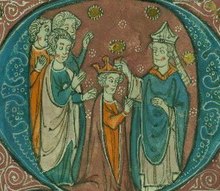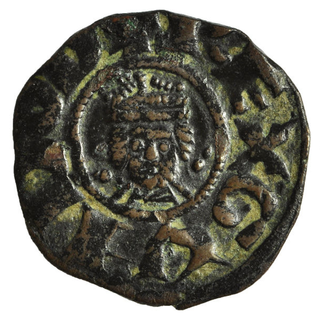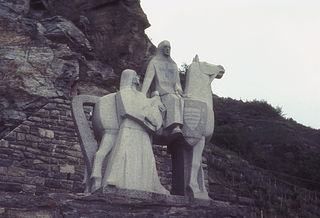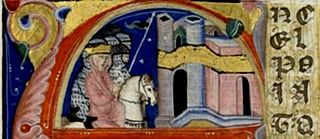
Amalric of Nesle (died 1180) was a French prelate from Nesle in Picardy. He was prior of the Holy Sepulcher by 1151. He was Latin patriarch of Jerusalem by 1158 to 1180. He died October 6, 1180, in the Kingdom of Jerusalem.

Amalric of Nesle (died 1180) was a French prelate from Nesle in Picardy. He was prior of the Holy Sepulcher by 1151. He was Latin patriarch of Jerusalem by 1158 to 1180. He died October 6, 1180, in the Kingdom of Jerusalem.
Amalric or Amalaric is a personal name derived from the tribal name Amal and ric meaning "ruler, prince".

Year 1180 (MCLXXX) was a leap year starting on Tuesday of the Julian calendar.

Baldwin IV (1161–1185), called the Leper King, was the king of Jerusalem from 1174 until his death in 1185. He was admired by his contemporaries and later historians for his willpower and dedication to the Latin Kingdom in the face of debilitating leprosy. Choosing competent advisers, Baldwin ruled a thriving crusader state and succeeded in protecting it from the Muslim ruler Saladin.

Guy of Lusignan was a French Poitevin knight who reigned as the king of Jerusalem from 1186 to 1192 by right of marriage to Sibylla, and King of Cyprus from 1192 to 1194.

The Zengiddynasty was a Sunni Muslim dynasty of Turkoman origin, which ruled parts of the Levant and Upper Mesopotamia on behalf of the Seljuk Empire and eventually seized control of Egypt in 1169. In 1174 the Zengid state extended from Tripoli to Hamadan and from Yemen to Sivas. The dynasty was founded by Imad ad-Din Zengi.

The Latin Patriarchate of Jerusalem is the Latin Catholic ecclesiastical patriarchate in Jerusalem, officially seated in the Church of the Holy Sepulchre. It was originally established in 1099, with the Kingdom of Jerusalem encompassing the territories in the Holy Land newly conquered by the First Crusade. From 1374 to 1847 it was a titular see, with the patriarchs of Jerusalem being based at the Basilica di San Lorenzo fuori le Mura in Rome. Pope Pius IX re-established a resident Latin patriarch in 1847.

Sibylla was the queen of Jerusalem from 1186 to 1190. She reigned alongside her husband Guy of Lusignan, to whom she was unwaveringly attached despite his unpopularity among the barons of the Kingdom of Jerusalem.

Blondel de Nesle – either Jean I of Nesle or his son Jean II of Nesle – was a French trouvère.

Isabella I was reigning Queen of Jerusalem from 1190 to her death in 1205. She was the daughter of Amalric I of Jerusalem and his second wife Maria Comnena, a Byzantine princess. Her half-brother, Baldwin IV of Jerusalem, engaged her to Humphrey IV of Toron. Her mother's second husband, Balian of Ibelin, and his stepfather, Raynald of Châtillon, were influential members of the two baronial parties. The marriage of Isabella and Humphrey was celebrated in Kerak Castle in autumn 1183. Saladin, the Ayyubid sultan of Egypt and Syria, laid siege to the fortress during the wedding, but Baldwin IV forced him to lift the siege.

Alice of Champagne was the queen consort of Cyprus from 1210 to 1218, regent of Cyprus from 1218 to 1223, and of Jerusalem from 1243 to 1246. She was the eldest daughter of Queen Isabella I of Jerusalem and Count Henry II of Champagne. In 1210, Alice married her step-brother King Hugh I of Cyprus, receiving the County of Jaffa as dowry. After her husband's death in 1218, she assumed the regency for their infant son, King Henry I. In time, she began seeking contacts within her father's counties in France to bolster her claim to Champagne and Brie against her cousin, Theobald IV. However, the kings of France never acknowledged her claim.
Baldwin of Ibelin, also known as Baldwin II of Ramla, was an important noble of the Kingdom of Jerusalem in the 12th century and was lord of Ramla from 1169-1186. He was the second son of Barisan of Ibelin, and was the younger brother of Hugh of Ibelin and older brother of Balian of Ibelin. He first appears in the historical record as a witness to charters in 1148.

Nesle is a commune in the Somme department in Hauts-de-France in northern France.

Maria Komnene, Latinized Comnena, was the queen of Jerusalem from 1167 until 1174 as the second wife of King Amalric. She occupied a central position in the Kingdom of Jerusalem for twenty years, earning a reputation for intrigue and ruthlessness.

Joan of Dammartin was Queen of Castile and León by marriage to Ferdinand III of Castile. She also ruled as Countess of Ponthieu (1251–1279) and Aumale (1237–1279). Her daughter, the English queen Eleanor of Castile, was her successor in Ponthieu. Ferdinand II, Count of Aumale, her son and co-ruler in Aumale, predeceased her, thus she was succeeded by her grandson John I, Count of Aumale.

Ablaincourt-Pressoir is a commune in the Somme department in Hauts-de-France in northern France.

Aimery or Aymery of Limoges, also Aimericus in Latin, Aimerikos in Greek and Hemri in Armenian, was a Roman Catholic ecclesiarch in Frankish Outremer and the fourth Latin Patriarch of Antioch from c. 1140 until his death. Throughout his lengthy episcopate he was the most powerful figure in the Principality of Antioch after the princes, and often entered into conflict with them. He was also one of the most notable intellectuals to rise in the Latin East.
Raoul le Bon ', also known as Raoul III de Nesle, was the Count of Soissons from 1180. He was the third son of Raoul II de Nesle and Gertrude de Montaigu.
Hugh IV of Saint-Pol from the House of Campdavaine, son of Anselm of Saint-Pol, was count of Saint-Pol from 1174 to his death, and lord of Demotika (Didymoteicho) in Thrace in 1204–05. He participated in the Third and Fourth Crusades.
Drogo of Nesle, a relative of Ralph, Lord of Soissons, was a knight who joined the army of Emicho, Count of Flonheim. He was one of the knights that survived the violent dispersal of Emicho's People's Crusade army by Hungarian forces during the First Crusade. Later Drogo, along with Clarembald of Vendeuil, joined the forces of Hugh, Count of Vermandois in Constantinople. He later joined the army of Godfrey of Bouillon.
Conon of Nesle, son of Raoul II of Nesle and Gertrude, daughter of Lambert, Count of Montaigu. Châtelain of Bruges, Count of Soissons. Conon became Count of Soissons upon the death of his uncle Yves II in 1178.